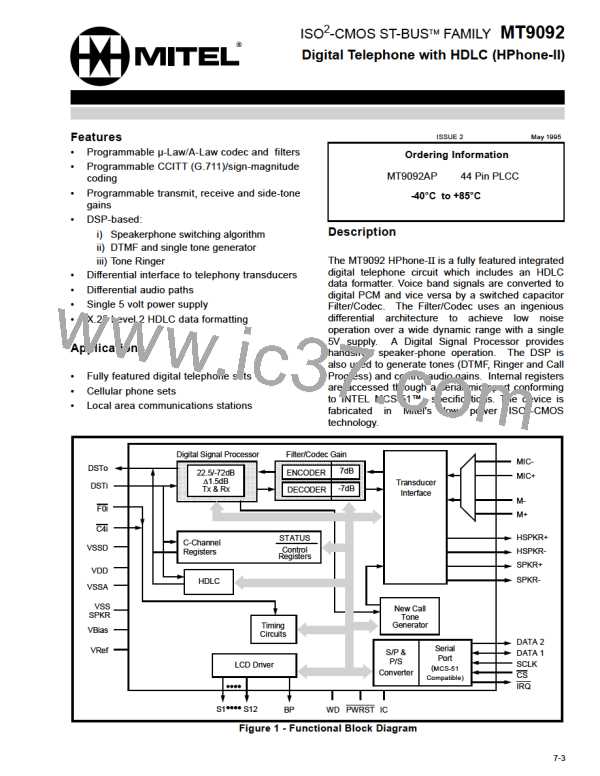MT9092
The data streams operate at 2048kb/s and are Time
Division Multiplexed into 32 identical channels of
64kb/s bandwidth. Frame Pulse (a 244nSec low
going pulse) is used to parse the continuous serial
data streams into the 32 channel TDM frames. Each
frame has a 125µSecond period translating into an 8
kHz frame rate. Valid frame pulse occurs when F0i is
logic low coincident with a falling edge of C4i. C4i
has a frequency (4096MHz) which is twice the data
rate. This clock is used to sample the data at the 3/4
bit-cell position on DSTi and to make data available
on DSTo at the start of the bit-cell. C4i is also used
to clock the HPhone-II internal functions (i.e., DSP,
Filter/CODEC, HDLC) and to provide the channel
timing requirements.
Ch EN - C-Channel
1
Channel
1
conveys
the
control/status
information for Mitel’s layer 1 transceiver. The
full 64kb/s bandwidth is available and is
assigned according to which transceiver is
being used. Consult the data sheet for the
selected transceiver for its bit definitions and
order of bit transfer. When this bit is high
register data is transmitted on DSTo. When low,
this timeslot is tri-stated on DSTo. Receive C-
Channel data (DSTi) is always routed to the
register regardless of this control bit's logic
state. C-channel data is transferred on the ST-
BUS MSB first by the HPhone-II.
Ch EN and Ch EN - B1-Channel and B2-Channel
2
3
The HPhone-II uses only the first 4 channels of the
32 channel frame. These channels are always
defined, beginning with the first channel after frame
pulse, as shown in Figure 7 (DSTi and DSTo channel
assignments). Channels are enabled independantly
Channels 2 and 3 are the B1 and B2 channels,
respectively. These bits (Ch EN and Ch EN)
2
3
are used to enable the PCM channels from/to
the HPhone-II as required.
by the four control bits Ch En -Ch En residing in the
Timing Control Register (address15h).
0
3
Transmit PCM on DSTo
When high, PCM from the Filter/CODEC and DSP is
transmitted on DSTo in the selected ST-BUS
channel. When low, DSTo is forced to logic 0 for the
Ch EN - D-Channel
0
Channel 0 conveys the D-Channel HDLC
information. Since this function is dedicated to
16kb/s operation, only the first two bits (LSB's)
of the octet are required; the remaining six bits
of the D-Channel octet carry no information and
corresponding timeslot. If both Ch EN and Ch EN
2
3
are enabled, default is to channel 2.
Receive PCM from DSTi
are tri-stated. When CH EN is high, HDLC data
0
is transmitted on DSTo. When low, DSTo is
forced to logic 0 for the two least significant bit
When high, PCM from DSTi is routed to the DSP and
Filter/CODEC in the associated channel. If both
positions.
Incoming DSTi data is always
routed to the HDLC block regardless of this
control bit's logic state.
Ch EN and Ch EN are enabled the default is to
2
3
channel 2.
125 µs
F0i
CHANNEL 0 CHANNEL 1 CHANNEL 2
CHANNEL 3
B2-channel
CHANNELS 4 - 31
Not Used
DSTi,
DSTo
D-channel
C-channel
B1-channel
LSB first
for D-
Channel
MSB first for C, B1 - & B2-
Channels
Figure 7 - ST-BUS Channel Assignment
7-19

 MITEL [ MITEL NETWORKS CORPORATION ]
MITEL [ MITEL NETWORKS CORPORATION ]